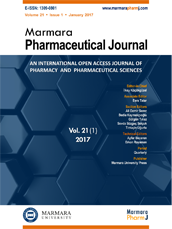Editor-in-Chief
Hatice Kübra Elçioğlu
Vice Editors
Levent Kabasakal
Esra Tatar
Online ISSN
2630-6344
Publisher
Marmara University
Frequency
Bimonthly (Six issues / year)
Abbreviation
J.Res.Pharm.
Former Name
Marmara Pharmaceutical Journal
Marmara Pharmaceutical Journal
2018 , Vol 22 , Issue 1
Cocos nucifera L. endosperm promotes healing of excised wound in BALB/c mice
1Institute of Pharmaceutical Sciences, National Institutes of Health, University of the Philippines Manila, Ermita, Manila, Philippines2College of Pharmacy, Department of Pharmacy, University of the Philippines Manila, Ermita, Manila, Philippines
3Department of Anatomy, College of Medicine, University of the Philippines Manila, Ermita, Manila, Philippines
4Institute of Molecular Biology and Biotechnology, National Institutes of Health, University of the Philippines Manila, Ermita, Manila, Philippines
5Department of Biology, College of Arts and Sciences, University of the Philippines Manila, Ermita, Manila, Philippines DOI : 10.12991/mpj.2018.48 Mature endosperm of Cocos nucifera L. (family Arecaceae) has been used in folkloric medicine as wound healing agent. However, valuable scientific evidence of its traditional use has not yet been verified. This study evaluates the wound healing activity of C. nucifera endosperm on the excised wound in BALB/c mice. Three concentrations (30%, 60% and 90%) of C. nucifera endosperm were prepared as ointment using petroleum jelly as base. The safety of the formulation was evaluated using dermal irritation test. The prepared concentrations, Solcoseryl® ointment (positive control) and petroleum jelly (negative control) were topically applied daily on the excised wound and observed for wound healing activity for 14 days, with histological evaluations at days 7 and 14. The 90% C. nucifera endosperm ointment showed no clinical signs of dermal irritation during the study duration, confirming the safety for topical usage of all the C. nucifera formulation. All groups demonstrated scab formation and wound contraction at days 7 and 9, respectively. Healing of the wounds, manifested by distinct wound contraction, was observed at day 14, with 60% C. nucifera endosperm exhibiting significant activity compared to the negative control (p=0.009) and untreated (p=0.046) groups. It also displayed the highest activity, with notable similarity in the activity of Solcoseryl®, and revealed the most organized epidermis comparable to normal skin. This study validates the folkloric use of C. nucifera endosperm in facilitating wound healing process, with 60% C. nucifera endosperm exhibiting the most desirable activity. Keywords : Cocos nucifera ; endosperm ; wound healing ; dermal irritation

